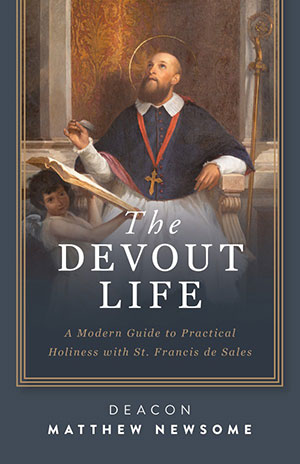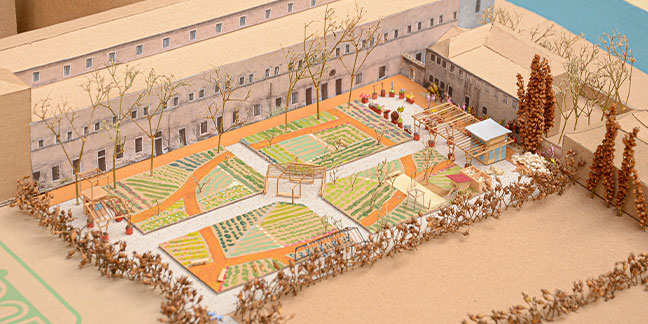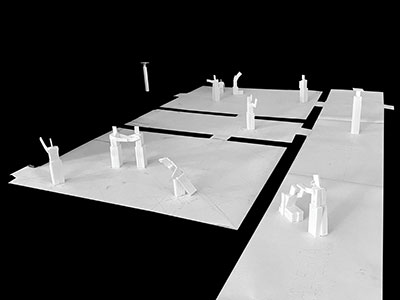Local author applies wisdom from St. Francis de Sales to the lives of modern Catholics in ‘The Devout Life’
 Devotion is a central theme in Deacon Matthew Newsome’s life. He is especially devoted to his wife and their seven children, his ministry, and God. It’s also a key component of his writing, a decades-long endeavor now experiencing a fresh flowering with the publishing of his first book, “The Devout Life: A Modern Guide to Practical Holiness with St. Francis de Sales” to be released June 20 by Sophia Institute Press.
Devotion is a central theme in Deacon Matthew Newsome’s life. He is especially devoted to his wife and their seven children, his ministry, and God. It’s also a key component of his writing, a decades-long endeavor now experiencing a fresh flowering with the publishing of his first book, “The Devout Life: A Modern Guide to Practical Holiness with St. Francis de Sales” to be released June 20 by Sophia Institute Press.
“I’m very excited by it,” he said. “Ever since I was a kid, I’ve always wanted to be a published author.”
Deacon Newsome writes a regular column for the Catholic News Herald, and his articles have appeared in other Catholic publications including The Deacon, This Rock (now Catholic Answers Magazine) and Envoy. He is the Catholic campus minister at Western Carolina University, and his home parish is St. Mary Mother of God in Sylva.
As an adult convert to the Catholic faith, he said he never would have guessed his first book would be about St. Francis de Sales, a 17th-century bishop he credits with being 300 years ahead of the Universal Call to Holiness promulgated by Pope Paul VI in 1964.
In “An Introduction to the Devout Life,” first published in 1609, St. Francis de Sales gives practical advice to attain holiness in ways that fit the lives of laypeople. Deacon Newsome’s book takes the saint’s teachings from this spiritual classic and applies them to Catholics in the 21st century.
“St. Francis de Sales has a lot of wisdom, and how many people aren’t reading it because they don’t think that they can pick up and read a 400-year-old book by a French bishop?” Deacon Newsome said.
Like the original, the book is organized in five sections that Deacon Newsome likens to the Parable of the Sower. The book starts by helping readers “prepare the soil of their hearts” and progresses through the planting, growing and tending of their spiritual gardens with practical advice for incorporating prayer into their daily lives and growing in virtues. Each chapter is short and accessible with discussion questions at the end.
“The person who is going to benefit from this book the most is someone who is already a committed Catholic,” Deacon Newsome said. “They’re going to Mass.
They’re committed to the faith, but they’re looking for the next step. They might not be satisfied with just being a Sunday Catholic.”
The inspiration for Deacon Newsome’s book on the saintly French bishop surfaced four years ago as he and his wife Joannie were seeking to increase their own holiness. They were looking for a devotional book to read after their evening prayers. Deacon Newsome recommended “An Introduction to the Devout Life,” and they started reading it together for the first time.
“St. Francis de Sales was most famous for his down-to-earth homilies that explained the complexities of the Christian faith in simple ways the people of his age could understand,” Deacon Newsome said, “and that came through in his writing as well.”
As they went through the book, Deacon Newsome said he did a fair amount of translating in the sense of culture and context. That’s when Joannie suggested that he write a book so he could help others understand the teachings more thoroughly as well. A prolific reader who has taught grammar and writing to their homeschooled children for years, she also worked with her husband to refine the manuscript and write the discussion questions.
“My wife is the best editor I know,” Deacon Newsome said, noting they worked in tandem throughout the writing process.
Authoring an update to a spiritual classic is a notable first foray into book publishing for anyone, but the seeds of “The Devout Life” were planted long ago.
“For the past 15 years I’ve been working in campus ministry helping young adults understand and appropriate the faith and put it into practice,” Deacon Newsome said. “I’ve worked as part of our lay ministry program. I’ve engaged in catechist training. My whole vocation, my whole work is helping people to understand these things, but it’s very humbling to think that I could update a saint because I am not a saint.”
If you’re looking for your next read, consider taking one step closer to ‘The Devout Life’ with Deacon Newsome.
— Annie Ferguson
TO ORDER: www.sophiainstitute.com/product/the-devout-life
VATICAN CITY — Commemorating 10 years since the election of Pope Francis, the Vatican will physically represent the teachings of his encyclicals at the Venice Biennale international architecture exhibition May 20 to Nov. 26.
 A model depicts the garden that will be part of the Holy See’s pavilion at the 2023 Venice Biennale architecture exhibition. The space is meant to represent Pope Francis’ ecological encyclical “Laudato si’, On Care for Our Common Home.” (CNS | Courtesy Studio Albori)
A model depicts the garden that will be part of the Holy See’s pavilion at the 2023 Venice Biennale architecture exhibition. The space is meant to represent Pope Francis’ ecological encyclical “Laudato si’, On Care for Our Common Home.” (CNS | Courtesy Studio Albori)
The Vatican’s exhibit, titled “Social Friendship: Meeting in the Garden,” will take visitors through scenes in which person-like “figures,” holding their arms open in welcome and acting out scenes of dialogue, convey themes inspired by the encyclical “Fratelli Tutti, on Fraternity and Social Friendship.”
The exhibit will then lead to a garden constructed of reused materials with plots growing vegetables from different parts of the world, chicken coops, seed storage facilities and rest areas. The space is intended to be one of contemplation and represent Pope Francis’ ecological encyclical “Laudato si, On Care for Our Common Home.”
Part of the exhibition will feature work by Portuguese architect Álvaro Siza, recipient of the 1992 Pritzker Prize, which is widely considered to be the highest honor in the field of architecture.
At a news conference presenting the exhibit April 18, Cardinal José Tolentino de Mendonca, prefect of the Dicastery for Culture and Education, said the Vatican’s involvement in the exhibition is an “extraordinary opportunity” since architecture is a “practical laboratory of the future, not far from typically spiritual questions.”
The Vatican’s exhibit is both an “intense political and poetic declaration about what a meeting between human beings can become,” he said, and it “puts all living things in architecture, making us all jointly responsible for our common home.”
“Over the 10 years of his pontificate, Pope Francis has acted and spoken on involving all, without forgetting the peripheries, the poor and refugees,” said Cardinal Tolentino. “This already constitutes a great legacy for the future of all those who desire a world that is more just and less wounded by social inequalities, and that is evident in the two parts of the Holy See’s pavilion.”
 A model represents the figures that are part of the Holy See’s pavilion at the 2023 Venice Biennale architecture exhibition. The figures are meant to represent the teachings of Pope Francis’ encyclical “Fratelli Tutti, on Fraternity and Social Friendship.” (CNS | Courtesy Álvaro Siza) The Vatican pavilion will be assembled at the Benedictine Abbey of San Giorgio Maggiore in Venice, which will bring visitors “closer to the daily life of a Benedictine monastery and its Rule, opening the possibility for a renewed dialogue with those emblematic spaces of the architectural tradition,” the dicastery said in a statement.
A model represents the figures that are part of the Holy See’s pavilion at the 2023 Venice Biennale architecture exhibition. The figures are meant to represent the teachings of Pope Francis’ encyclical “Fratelli Tutti, on Fraternity and Social Friendship.” (CNS | Courtesy Álvaro Siza) The Vatican pavilion will be assembled at the Benedictine Abbey of San Giorgio Maggiore in Venice, which will bring visitors “closer to the daily life of a Benedictine monastery and its Rule, opening the possibility for a renewed dialogue with those emblematic spaces of the architectural tradition,” the dicastery said in a statement.
It will be the second time the Vatican has participated in the bi-yearly architecture exposition, now in its 18th edition. In 2018, it created an exhibit titled “Vatican Chapels” in which 10 architects each built small chapels, some futuristic and others rustic, in a wooded area of Venice.
— Justin McLellan, Catholic News Service

